The SIP (Sound Integrated Processor) speakers market is forecast to expand from USD 184.4 million in 2025 to USD 291.9 million by 2035, reflecting a CAGR of 4.7%. SIP speakers are used in a wide range of applications, including consumer electronics, home entertainment systems, and automotive audio solutions.
The SIP speakers market is driven by increasing demand for high-quality audio systems, rising popularity of smart homes, and growing demand for personalized sound experiences. As wireless audio technologies and voice-activated systems continue to evolve, SIP speakers are gaining traction in IoT-enabled devices and connected home ecosystems.
The SIP speakers market will be further supported by the integration of AI and machine learning into sound processing, enabling more dynamic audio control and an enhanced user experience. The increasing adoption of smart speakers and immersive sound solutions in consumer products, along with innovations in portable speakers and automotive sound systems, will continue to drive the market forward. As demand for advanced audio technology and multi-device connectivity rises, SIP speakers will see greater integration into next-generation audio systems, driving steady market growth through 2035.
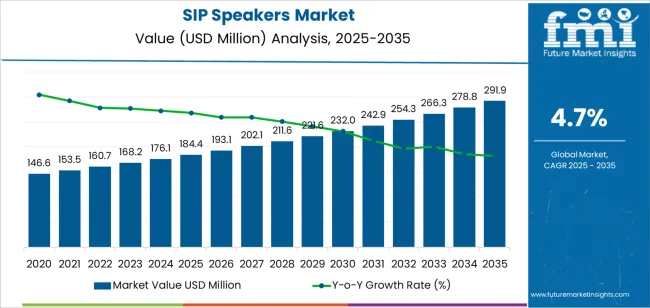
The compound absolute growth analysis for the SIP speakers market highlights the total market expansion over the 10-year forecast period from 2025 to 2035. Starting at USD 184.4 million in 2025, the market is expected to grow to USD 291.9 million by 2035, reflecting an increase of USD 107.5 million. This absolute growth of USD 107.5 million indicates steady expansion, driven by technological advancements in audio processing and increasing demand for high-quality sound systems across sectors.
Between 2025 and 2030, the market will expand from USD 184.4 million to USD 232 million, contributing an increase of USD 47.6 million. This growth is driven by the increased adoption of wireless and smart audio technologies in consumer electronics and automotive audio systems. In the second phase, from 2030 to 2035, the market will continue its growth trajectory, reaching USD 291.9 million, with an increase of USD 59.9 million. This phase will benefit from the rising demand for multi-room audio solutions, immersive sound systems, and AI-enhanced audio processing, further accelerating market expansion.
| Metric | Value |
|---|---|
| Market Value (2025) | USD 184.4 million |
| Market Forecast Value (2035) | USD 291.9 million |
| Forecast CAGR (2025-2035) | 4.7% |
The SIP speakers market is expanding as organizations replace legacy analog public-address and paging systems with network-connected solutions that support digital communications and IP telephony. SIP (Session Initiation Protocol) speakers integrate directly with VoIP systems or SIP servers, enabling centralized control of audio announcements, emergency alerts, and background music over a building’s IT network. They are especially popular in sectors such as education, healthcare, transportation hubs, public venues, and industrial facilities where zones of paging, evacuation messaging, and live announcements must seamlessly coexist. The increase in demand for unified communication platforms and real-time audio over IP supports market growth for SIP speakers.
Another key driver is the convergence of feature-rich connectivity and simplified installation. Modern SIP speakers often support Power over Ethernet (PoE), multicast streaming, remote configuration, and integration into cloud or enterprise management systems-reducing deployment time, cabling complexity, and operating cost. Manufacturers are innovating with wall-mount, ceiling-tile, and outdoor weather-resistant models tailored to varied environments. However, wide adoption faces challenges such as integration with legacy analog infrastructure, skepticism over cybersecurity of networked audio endpoints, and competition from simpler audio systems. Nonetheless, the combination of digital transformation in communications and the need for scalable, network-based paging and alerting systems suggests that the SIP speakers market is poised for continued steady growth.
The SIP speakers market is segmented by product type and application. The leading product type is ceiling-mounted SIP speakers, holding 40% of the market share, while the dominant application segment is commercial use, accounting for 30% of the market. These segments are driving the market’s growth, supported by the increasing demand for high-quality, durable audio solutions in various commercial and public spaces.
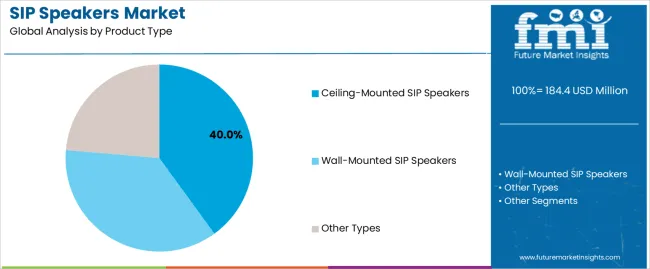
The ceiling-mounted SIP speakers segment leads the market, capturing 40% of the market share. Ceiling-mounted speakers are commonly used in commercial environments where they provide clear, consistent audio coverage without taking up valuable floor or wall space. These speakers are ideal for large spaces such as offices, conference rooms, and retail environments, as they can distribute sound evenly throughout the area.
Ceiling-mounted SIP speakers are favored for their aesthetic appeal and ability to blend seamlessly with the ceiling, maintaining a clean, unobtrusive design while offering high-quality sound. The demand for these speakers is driven by the growing adoption of VoIP systems, public address systems, and audio distribution networks in commercial environments. As businesses continue to integrate SIP-based communication systems for improved collaboration and customer experience, the ceiling-mounted SIP speaker segment is expected to maintain its leadership in the market.
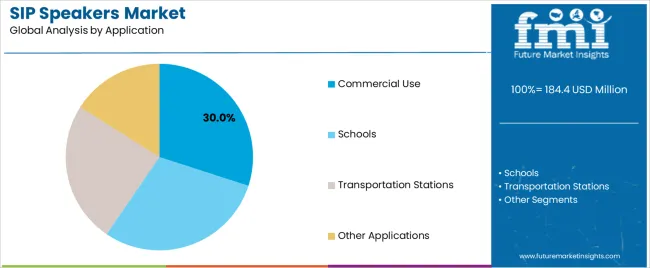
The commercial use application segment is the largest in the SIP speakers market, accounting for 30% of the market share. Commercial establishments such as offices, retail stores, shopping malls, and hotels are significant users of SIP speakers. These environments rely on SIP speakers for communication, announcements, music, and emergency alerts, making high-quality audio solutions essential for day-to-day operations.
The rise of integrated communication systems in commercial spaces, including VoIP and IP-based public address systems, has driven the adoption of SIP speakers. These speakers are particularly valued for their scalability, ease of integration with existing network infrastructures, and ability to deliver clear audio for both communication and entertainment purposes. As the demand for advanced communication and audio systems in commercial settings continues to grow, the commercial use segment is expected to remain a dominant force in the SIP speaker market.
The SIP speakers market is advancing alongside growing adoption of network based public address and paging systems driven by digital transformation in sectors such as education, healthcare, industrial, transportation and retail. SIP (Session Initiation Protocol) speakers use IP networks to deliver announcements, alerts and background audio as part of unified communications or safety systems. Their ability to integrate with VoIP, PoE (Power over Ethernet) and centralized management platforms makes them increasingly popular for modern infrastructure and smart building projects. At the same time, regional broadband infrastructure, enterprise replacement cycles and standards for digital audio control influence the adoption rate.
What Are the Primary Growth Drivers For the SIP Speakers Market?
Several factors fuel the growth of this market. First, the shift from analogue PA systems to IP network driven audio solutions in new and retrofit construction creates demand for SIP speakers that support streamlined cabling and centralised control. Second, increasing emphasis on life safety systems, emergency notification and real time alerts across public venues, campuses, factories and transportation hubs drives demand for speakers that support multicast, remote zone control and rapid message distribution. Third, the proliferation of large scale projects in emerging regions—such as smart cities, transport infrastructure and education campuses—broadens volumes for network based audio solutions. Fourth, integration trends—such as incorporation of ambient audio, background music and paging into unified communications platforms—enhance the value proposition of SIP speakers beyond simple announcements.
What Are The Key Restraints In the SIP Speakers Market?
Despite positive momentum, the SIP speakers market faces several constraints. The higher cost of network enabled speakers, including licensing, IP infrastructure and installation labour, may deter uptake in cost sensitive retrofit or small scale projects. Compatibility and interoperability issues across IP PBX, VoIP platforms and legacy audio systems increase implementation complexity. In regions where broadband infrastructure is limited or PoE support is weak, adoption may be slower. Additionally, awareness of IP based audio benefits versus traditional systems may be limited among smaller organisations, delaying upgrades.
What Are The Emerging Trends In the SIP Speakers Market?
Emerging trends in the SIP speakers market include mounting emphasis on cybersecurity, with encryption and speaker authentication becoming differentiators for systems used in critical infrastructure and public safety environments. There is also growing use of cloud managed audio platforms, enabling remote monitoring, firmware updates and centralised zone control across multiple sites. PoE+ and low voltage installation are increasingly standard, reducing cabling costs and simplifying deployment. Furthermore, hybrid solutions that combine voice paging, background music, emergency alerts and voice assistant integration are gaining traction in commercial venues. Finally, regional growth in Asia Pacific, Latin America and the Middle East North Africa regions is accelerating as infrastructure investment rises and demand for integrated IP audio systems increases.
The SIP (Speaker Integration Protocol) speakers market is growing as demand for high-quality, integrated audio solutions increases across industries such as consumer electronics, automotive, and smart home technologies. SIP speakers, which offer seamless integration with smart devices and audio systems, are becoming essential in various sectors where enhanced sound quality and connectivity are key priorities. As smart homes and IoT-enabled devices gain popularity, the need for SIP speakers is accelerating. Emerging markets like China and India are experiencing rapid growth due to increasing consumer demand for smart home devices, while developed economies such as the USA and Germany continue to lead in technological innovation and high-end audio systems. This analysis explores the drivers behind the growth of the SIP speakers market across different countries.
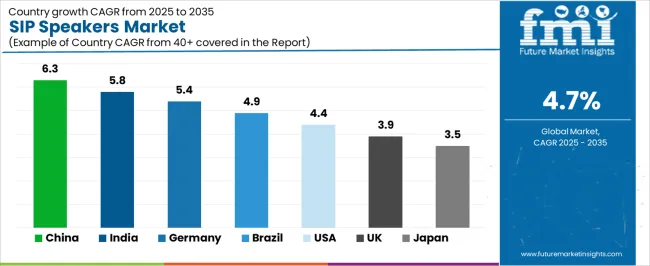
| Country | CAGR (2025-2035) |
|---|---|
| China | 6.3% |
| India | 5.8% |
| Germany | 5.4% |
| Brazil | 4.9% |
| USA | 4.4% |
| United Kingdom | 3.9% |
| Japan | 3.5% |
China leads the SIP speakers market with a CAGR of 6.3%. The rapid adoption of smart home technologies and the growing demand for integrated audio solutions in consumer electronics are key drivers of this market. As China’s middle class continues to grow, consumers are increasingly investing in high-quality audio products, including SIP speakers, for enhanced home entertainment experiences.
China’s booming electronics manufacturing sector, combined with the increasing availability of affordable smart home devices, further fuels the market for SIP speakers. The growing popularity of IoT-enabled devices in smart homes, coupled with the rise of connected audio systems, is creating significant demand for these speakers. With China’s focus on expanding the IoT ecosystem and modernizing urban living, the market for SIP speakers will continue to grow rapidly.
India’s SIP speakers market is growing at a CAGR of 5.8%. The increasing adoption of smart home solutions, particularly in urban areas, is driving demand for integrated audio systems. As disposable incomes rise and consumer preferences shift toward advanced technology, there is a growing need for high-quality, easy-to-use audio solutions like SIP speakers.
India’s young, tech-savvy population is playing a major role in driving this growth, particularly through the increasing use of smartphones, connected devices, and smart home technology. The expanding e-commerce sector and increasing internet penetration in India are also contributing to the rise of smart home devices, further boosting the demand for SIP speakers. As the country continues to embrace digital transformation and smart living, the market for SIP speakers is expected to experience steady growth.
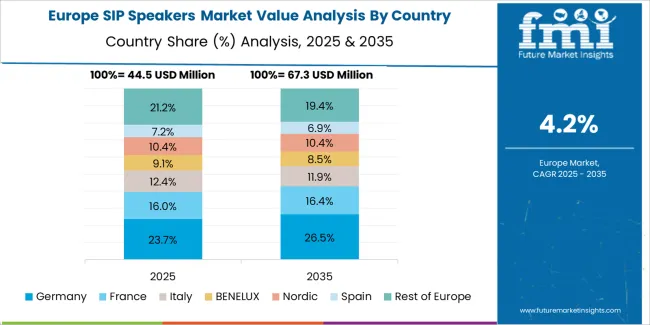
Germany’s SIP speakers market is projected to grow at a CAGR of 5.4%. As one of Europe’s leaders in consumer electronics and smart home technology, Germany is seeing steady demand for SIP speakers, driven by the growing adoption of home automation systems and connected devices. The increasing focus on high-quality audio solutions, especially for home entertainment, is contributing to the market’s growth.
Germany’s mature retail and electronics markets, coupled with rising interest in smart home systems, are fueling the demand for SIP speakers. The country’s commitment to technological innovation and the growing popularity of smart speakers and integrated audio solutions in homes and offices are key drivers of the market. As Germany continues to innovate in smart home solutions and enhance digital infrastructure, the demand for SIP speakers will remain strong.
Brazil’s SIP speakers market is expected to grow at a CAGR of 4.9%. The increasing demand for smart home devices, combined with the rise of connected audio systems in residential and commercial spaces, is driving the growth of the SIP speakers market in Brazil. As consumer preferences shift toward higher-quality audio experiences and integrated solutions, the demand for SIP speakers is rising.
The growing middle class, along with the increasing popularity of smartphones and IoT devices, is fueling demand for connected audio products. The development of smart cities and increasing urbanization in Brazil also contributes to the growing adoption of home automation technologies, further boosting the market for SIP speakers. As Brazil’s infrastructure continues to improve and the demand for digital solutions rises, the market for SIP speakers is expected to see steady growth.

The United States has a projected CAGR of 4.4% for the SIP speakers market. As one of the largest markets for consumer electronics and smart home technologies, the USA is seeing steady demand for SIP speakers. The adoption of voice-controlled speakers, smart home devices, and wireless audio systems in homes and offices is contributing to the growth of the market.
The growing interest in smart home automation, voice assistants like Amazon Alexa and Google Assistant, and the increasing popularity of home entertainment systems are key drivers of demand for SIP speakers. As the market continues to evolve with advancements in audio quality and IoT integration, the demand for SIP speakers in the USA will remain strong. Additionally, the rise of connected devices in the commercial sector and the shift toward more efficient, integrated solutions further supports market growth.
The United Kingdom’s SIP speakers market is projected to grow at a CAGR of 3.9%. The UK is experiencing a growing demand for connected audio solutions, particularly in the context of home automation systems and smart living. As the market for IoT devices and smart home technologies expands, there is increasing interest in SIP speakers for use in homes and offices.
The rise in disposable income, along with the increasing adoption of wireless and smart speakers, is contributing to the market’s growth. As consumer preferences shift toward integrated and high-quality audio solutions, the demand for SIP speakers will continue to rise. Additionally, the increasing focus on sustainability and energy-efficient solutions in the UK’s smart home sector is expected to drive further market growth.
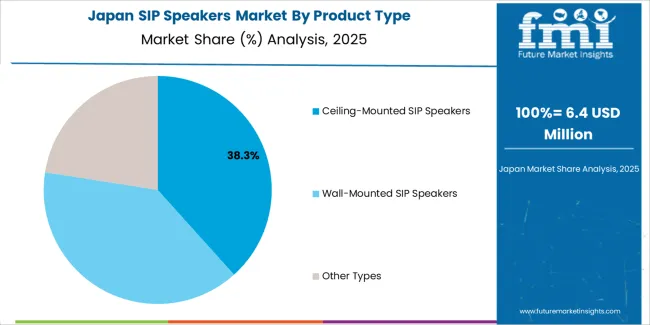
Japan’s SIP speakers market is expected to grow at a CAGR of 3.5%. Japan’s advanced electronics market, coupled with the country’s high interest in smart home devices, is supporting the demand for SIP speakers. The increasing adoption of IoT devices, along with Japan’s reputation for high-quality audio products, is contributing to the growth of the market.
Japan’s growing focus on smart home automation, along with the rising popularity of voice-controlled devices and connected audio systems, is driving the market for SIP speakers. The demand for integrated audio solutions in homes and offices is expected to increase as Japan continues to embrace smart living technologies. As the country continues to invest in IoT infrastructure and connected devices, the market for SIP speakers is likely to grow, although at a slower pace compared to emerging markets.
In the SIP (Session Initiation Protocol) speakers market, companies such as Grandstream Networks, Inc. (holding about 16% share), CyberData Corporation, Valcom, TONMIND, KENEUC, ZYCOO, ALGO, Snom, RUKOTA, Shenzhen Oub Technology Co., Ltd., AXIS (2N) and Fanvil Technology Co., Ltd. compete in a market that was valued around USD 182 million in 2024 and is forecast to reach about USD 249 million by 2031 with a compound annual growth rate of approximately 4.6%. Growth is being driven by increasing deployment of IP-based communication systems, the move from analog to digital infrastructure, and demand for networked speaker solutions in commercial, education, industrial and public-address environments.
These firms compete through several key tactics. One tactic focuses on product features and performance: companies highlight support for digital protocols (SIP over IP networks), PoE (Power over Ethernet), integration with VoIP systems, multi-zone paging and emergency broadcast capabilities. For example, the Grandstream GSC3510 SIP Intercom Speaker exemplifies a networked speaker designed for modern IP environments. Another tactic emphasises ecosystem and service-offer: firms partner with system integrators, ensure device compatibility with a wide range of VoIP platforms, and offer firmware updates, analytics and remote management features. A further dimension is regional reach and distribution: companies expand across growth markets, tailor language and compliance (e.g., local standards, certifications) and maintain distribution for projects in schools, hospitals, factories and transport hubs. Marketing materials and brochures typically highlight features such as number of supported zones, speaker power rating (watts), supported codecs, integration with IP-PBX, mounting types (ceiling, wall, outdoor) and emergency alert functions. By aligning their offerings with customer priorities such as flexible deployment, network compatibility, and high reliability, these vendors are positioned to strengthen their presence in the evolving SIP speakers market.
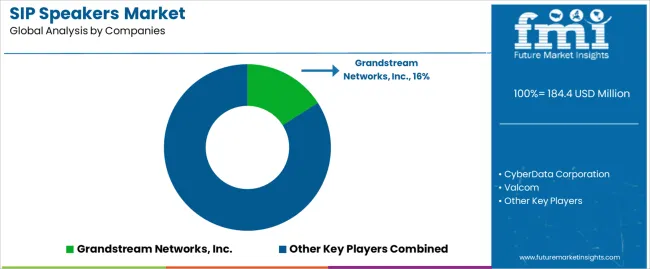
| Items | Details |
|---|---|
| Quantitative Units | USD Million |
| Regions Covered | Asia Pacific, Europe, North America, Latin America, Middle East & Africa |
| Product Type | Ceiling-Mounted SIP Speakers, Wall-Mounted SIP Speakers, Other Types |
| Application | Commercial Use (30%), Schools, Transportation Stations, Other Applications |
| Key Companies Profiled | Grandstream Networks, Inc., CyberData Corporation, Valcom, TONMIND, KENEUC, ZYCOO, ALGO, Snom, RUKOTA, Shenzhen Oub Technology Co., Ltd., AXIS (2N), Fanvil Technology Co., Ltd. |
| Additional Attributes | The market analysis includes dollar sales by product type and application categories. It also covers regional adoption trends across major markets. The competitive landscape focuses on key manufacturers in the SIP speakers market, with innovations in ceiling-mounted, wall-mounted, and other types of speakers. Trends in the growing demand for SIP-based communication systems in commercial, educational, and transportation sectors are explored, along with advancements in network-based audio solutions and their integration into unified communication platforms. |
Product Type
The global SIP speakers market is estimated to be valued at USD 184.4 million in 2025.
The market size for the SIP speakers market is projected to reach USD 291.9 million by 2035.
The SIP speakers market is expected to grow at a 4.7% CAGR between 2025 and 2035.
The key product types in SIP speakers market are ceiling-mounted SIP speakers, wall-mounted SIP speakers and other types.
In terms of application, commercial use segment to command 30.0% share in the SIP speakers market in 2025.






Our Research Products

The "Full Research Suite" delivers actionable market intel, deep dives on markets or technologies, so clients act faster, cut risk, and unlock growth.

The Leaderboard benchmarks and ranks top vendors, classifying them as Established Leaders, Leading Challengers, or Disruptors & Challengers.

Locates where complements amplify value and substitutes erode it, forecasting net impact by horizon

We deliver granular, decision-grade intel: market sizing, 5-year forecasts, pricing, adoption, usage, revenue, and operational KPIs—plus competitor tracking, regulation, and value chains—across 60 countries broadly.

Spot the shifts before they hit your P&L. We track inflection points, adoption curves, pricing moves, and ecosystem plays to show where demand is heading, why it is changing, and what to do next across high-growth markets and disruptive tech

Real-time reads of user behavior. We track shifting priorities, perceptions of today’s and next-gen services, and provider experience, then pace how fast tech moves from trial to adoption, blending buyer, consumer, and channel inputs with social signals (#WhySwitch, #UX).

Partner with our analyst team to build a custom report designed around your business priorities. From analysing market trends to assessing competitors or crafting bespoke datasets, we tailor insights to your needs.
Supplier Intelligence
Discovery & Profiling
Capacity & Footprint
Performance & Risk
Compliance & Governance
Commercial Readiness
Who Supplies Whom
Scorecards & Shortlists
Playbooks & Docs
Category Intelligence
Definition & Scope
Demand & Use Cases
Cost Drivers
Market Structure
Supply Chain Map
Trade & Policy
Operating Norms
Deliverables
Buyer Intelligence
Account Basics
Spend & Scope
Procurement Model
Vendor Requirements
Terms & Policies
Entry Strategy
Pain Points & Triggers
Outputs
Pricing Analysis
Benchmarks
Trends
Should-Cost
Indexation
Landed Cost
Commercial Terms
Deliverables
Brand Analysis
Positioning & Value Prop
Share & Presence
Customer Evidence
Go-to-Market
Digital & Reputation
Compliance & Trust
KPIs & Gaps
Outputs
Full Research Suite comprises of:
Market outlook & trends analysis
Interviews & case studies
Strategic recommendations
Vendor profiles & capabilities analysis
5-year forecasts
8 regions and 60+ country-level data splits
Market segment data splits
12 months of continuous data updates
DELIVERED AS:
PDF EXCEL ONLINE
Sip Feeds Market Forecast and Outlook 2025 to 2035
Sippy Cups Market Analysis – Size, Growth & Trends to 2033
Anti Siphon Valves Market Analysis - Size, Share, and Forecast Outlook 2025 to 2035
Session Initiation Protocol (SIP) Trunk Market

Thank you!
You will receive an email from our Business Development Manager. Please be sure to check your SPAM/JUNK folder too.
Chat With
MaRIA